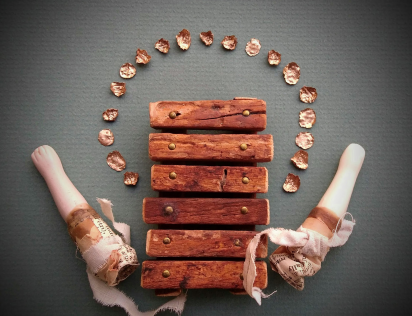Articles/Essays – Volume 55, No. 1
creation story
Podcast version of this piece.
He makes the light and the primeval oceans and the rapturous Word,
but I have the dirt
the ground the chthonic underbelly and sustenance of all. I have the
jewel-toned beetles and cavern cathedrals and the slick blesmols.
The translucent jellyfish and the elegant otherworldly bats. The
velutinous darkness I see when I close my eyes and look out is
what I create—
that moment of descending into something unknown
with limitless possibility. Black calla lilies and thick root webs and
lithe olms and the young coyotes with protruding ribcages.
Before I sculpt the earth
and the atmosphere too
I try to enjoy this night and remember my sliver of time before the
labor of creation. The time of loving and crying and walking
through snow floating down like tiny newborn stars. The time of
waking up to the bright marmalade sunrise shining through the
bathroom window and whispering to the daytime moon. I was a
lover eating rabbit stew
wondering how I could rupture so violently
so completely
and still move forward through time.
The old time of unknowing, of not knowing the unknown.
On the first day
I made the starling and then let its feathers become the centerpiece of
the highest world
glittering with iridescent speckles
letting the undertones of violet and turquoise shine through.
This
(I thought)
is the sky
the world’s favorite quilt: the starling as firmament.
I rest tonight and think about my large-souled days
like when my father taught me how to fish
or when I picked bucketfuls of fresh strawberries in spring
or flew through gilded air on a bicycle in June.
It is no coincidence then
that the words soil and soul are nearly identical sonic twins
seeing as the layers of my soul
like a stratigraphy
read certain scales of time
experience
and remember past lives fossilized in the sentient sensual sediment
of the body. The strata run horizontal like long thin snakes with
writhing bellies underneath my skin
varying in width
as some strands of time are denser with memory than others.
This is where I will begin and end
in remembering these moments of unknown beauty and quiet grit.
Underneath the soul’s many mineral deposits
the liquid core sends a pulse through the body
spilling blood through an ecosystem of veins. Here, at the heart, I
remember my shame
which smells like cinnamon—sharp and harsh and cathartic. Memory
may not be a reality
but it bends and melts into worlds both known and unknown
preserved in our salubrious soils.
I recall that I am a world unto myself
slowly dissolving until
at last at last my burning center is exposed
and burns hot and shimmers right before it erupts into a thousand
shining pieces that float like meteors in an unknown reservoir.
On the second day
I will make the dirt
a luscious loam with a dense liquid heart that beats and writhes and
fuels the world forward. It is the origin from which everything
else will flower and grow without my help, alone and unabated. I
will make the ground strong and soft
full of sculptures and sepulchres and pools of oil and iron. I will
create sandstone red as summer cherries and rough as a man’s
stubble, like thistles.
Worldmaking is an act of time grace and pain anger and patience
love. It is a birthing. I trust my body and create the underworld
the underneath the subterranean. The clay the silt the dirt the
sand. Within the soil of the world is where the fleshy self is
where secrets are whispered and sung. All things are taken into the
soft world of the earth in a returning
a homecoming that invites new life through transforming death. It
is where things are made radical and rejuvenated and why mud spread over the eyes gives sight. A body placed into the ground is
born anew
made supple through time and slithering annelids.
Note: The Dialogue Foundation provides the web format of this article as a courtesy. There may be unintentional differences from the printed version. For citational and bibliographical purposes, please use the printed version or the PDFs provided online and on JSTOR.


 Back to full Issue
Back to full Issue

